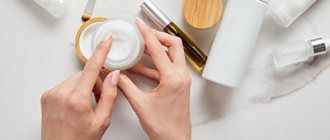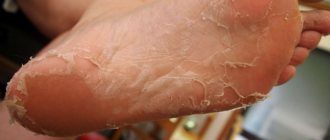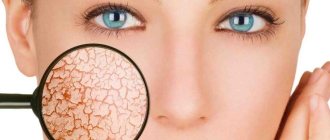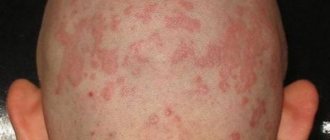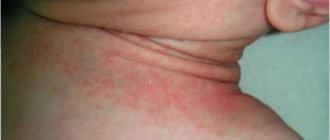Dry sensitive cracking skin: causes
Dry skin can be caused by a variety of factors:
- deficiency of vitamins A, B, E;
- disruptions in the functioning of the endocrine system;
- negative climatic and atmospheric influences;
- improper diet and imbalance of water balance in the body;
- chronic sleep disorders, etc.
The skin also often becomes dry due to age-related hormonal changes. Signs of dry aging skin:
- loss of elasticity and sagging – primarily in the cheeks, neck and chin;
- grayish tint;
- the appearance of pigmentation;
- the appearance of wrinkles.
Irritated skin, when it dries out, also often flakes and causes itching. What to do in such a situation? Pay special attention to facial care - independently and with the help of professionals.
Dry skin: why
Few people know, but dry skin is such a subtle problem that even a “moisturizing” cream can provoke it. How to avoid its appearance? And how to help the skin recover?
Leak protection
The skin can be compared to a brick wall, where keratinocytes (keratinized cells) serve as bricks, and three types of lipids serve as cement:
- fatty acids (Omega-3),
- cholesterol
- and ceramides.
The main function of this “structure” is to control transepidermal water loss and sweating, as well as protection against the penetration of pathogenic microorganisms and chemicals.
In addition, the cells of the upper layer of skin themselves contain natural moisturizing factor (NMF), the main components of which are:
- free carbolic and amino acids,
- urea,
- lactates,
- citrates
- and minerals.
These substances allow the stratum corneum to retain moisture and thereby maintain firmness and elasticity.
The hydrolipid mantle, which covers the stratum corneum and gives the skin softness, also helps to retain water in the skin. The mantle is formed from the secretion of the sebaceous glands and lipids synthesized by keratinocytes, and its disruption is one of the very first causes of dryness and inflammation.
Factors of "dryness"
1. External
- air dustiness,
- hardness and poor water quality,
- excessive UV exposure,
- free radicals,
- improper care.
2. Internal:
- lack of vitamins, minerals and fatty acids,
- some chronic diseases,
- heredity.
In the first case, factors act on several fronts at once. Air dust and “wrong” minerals in tap water draw water from the skin, acting as a powerful adsorbent.
Excess free radicals (chronic stress, atmospheric pollution, UV irradiation, smoking and others) destroy the protective layer of the skin.
As well as the use of cleansers containing surfactants (surfactants), alcohol and its derivatives, as well as drying care products and decorative cosmetics.
Internal risk factors “work” only in one direction - they disrupt the normal renewal of the skin and weaken its stability.
In fact, healthy skin successfully withstands the onslaught of adverse influences, at least for a long time. Therefore, the appearance of skin problems is always a sign of internal troubles.
How to support your skin
It is obvious that it is virtually impossible to “hide” from most external risk factors. While internal ones belong to the category of managed ones.
First of all, it is recommended to evaluate the level of “beauty” nutrients:
- vitamins , , ,
- minerals: iron, zinc, copper, selenium and silicon,
- Omega-3 fatty acids,
- as well as cholesterol,
the content is “lame” in most patients with dry skin. And both a deficiency and an excess of some of them (competitive interaction of nutrients with each other) matters.
It is worth paying attention to the health of the thyroid gland, the deficiency of hormones of which is manifested, among other things, by dryness and sagging skin, and the pathology itself is very widespread and represents a serious medical problem.
Liver disease and chronic renal failure, as well as cancer and blood diseases can also lead to dryness.
In addition, dry skin is the main symptom of atopic dermatitis, which can be confirmed or refuted by a blood test for total immunoglobulin E.
Proper care for dry skin
It is extremely difficult to independently accurately compose all the stages of care for dehydrated skin; the help of an experienced dermatocosmetologist will be especially useful in this. He will determine the causes of the phenomenon, develop a treatment program, give recommendations on how to care for dry, dehydrated skin after 40 years or at a younger age, and help with the choice of cosmetics for everyday care.
But the use of even the most expensive creams and lotions, peeling and massage at home in many cases is not able to successfully solve the problem of moisturizing dry, thin facial skin and returning it to the desired condition. In this case, hardware and injection cosmetology will come to the rescue, the services of which are provided at a high quality level and at a favorable price for clients by the MedBioSpectrum clinics in Moscow, Kashirka, and Ramenskoye.
What procedures are recommended for very dry facial skin?
The techniques used by our doctors are designed to restore the outer layer of the epidermis - its integrity and water-lipid balance. The choice of the optimal technology is made solely taking into account individual indicators - the state of the body, skin characteristics, age.
To treat dry facial skin, a cosmetologist may prescribe:
- hardware vacuum massage, which helps restore muscle tone and skin elasticity;
- biorevitalization – saturation of the epidermis with hyaluronic acid;
- mesotherapy – injections with vitamin cocktails;
- thread lifting – implantation of absorbable APTOS threads.
You can get additional information, find out how to get rid of dry skin around the eyes, and find out the cost of the procedure during an appointment with a cosmetologist at the MedBioSpectrum clinic - select a convenient time for your visit using the form on the website or call.
Why does the skin on your face peel and dry?
There is not a single woman who would not want to have smooth, velvety skin. It is so? But the reality is that we are constantly attacked by various bad weather. Either there is a strong cold wind outside, or the scorching sun, or low humidity. All this leads to the fact that the skin does not have time to adapt to environmental changes. It begins to fade, dry out and peel off.
In science this is called xerosis or xeroderma. Xerosis is caused by improper functioning of the sebaceous glands and, as a result, an insufficient amount of sebum is produced. Without it, the skin is deprived of hydration and protection from the external environment. In addition to the fact that it begins to peel off, the skin tightens and wrinkles. In general, everything that we don’t like so much.
Dry skin is most susceptible to premature aging. You've probably even noticed yourself that if you don't moisturize your skin regularly, then not only expression wrinkles, but also static ones begin to appear. Gradually they turn into deep creases that no longer disappear from the face.
Causes of dry skin
Let's see what causes the skin to dry out? First, let's look at internal factors.
- The simplest explanation for peeling skin is heredity. If at least one of your parents has the same problem, it is likely that it was passed on to you. People with thin skin are more often affected.
- Obviously, diseases also affect the condition of the skin. This could be diabetes mellitus, kidney failure, diseases associated with damage to the endocrine system and gastrointestinal tract, and oncology.
- The most common reason for our aesthetic imperfections is hormonal changes in the body and age-related changes. Everyone knows what metamorphoses our body can undergo in such states.
- Internal factors include a lack of vitamins in the body. Especially vitamin A, which is responsible for the condition of the epithelium.
- Poor nutrition and lifestyle, non-compliance with sleep patterns.
- Allergic reactions. They can be caused by some food products, plants, animals, or by the composition of cosmetics. About cosmetics in the next block.
External factors:
- Bad weather conditions: strong wind, frost, scorching sun, sudden temperature changes.
- Exposure to UV rays, which leads to the death of epidermal cells. At the same time, collagen fibers are destroyed. Without them, the skin loses tone and elasticity. When exposed to the sun for a long time, the skin dries out and you can get sunburn.
- Cosmetical tools. There are two sides of the coin here. Or you're using products that simply aren't suitable for your skin type. Or the cosmetics contain aggressive substances. For example, we advise you not to use cosmetics that contain alcohol. This is what leads to skin dehydration. A substance such as lanolin can cause an allergic reaction. Read the ingredients carefully.
- Incorrect care. Under no circumstances should you wash your face with hot water or rub it. This damages the surface of the epidermis, making it vulnerable to environmental influences. To soothe the skin, use products that contain oils or creams.
If you have tried all possible means of preventing and protecting against dry skin, but it is still flaking, consult a cosmetologist. The doctor will not immediately be able to eliminate peeling in one session. But at least he will determine the cause of the problem and prescribe a course of treatment. Don't delay going to the doctor.
Methods for treating dry skin in cosmetology
The methods below are suitable for treating dry skin and for prevention. In the autumn-winter period, you can’t go without these procedures! The main task is to saturate the skin with moisture and vitamins.
For a deeper and more serious effect, injection procedures are suitable - mesotherapy, biorevitalization, plasma lifting. Moisturizing occurs from the inside, the effect lasts longer than from creams.
- Mesotherapy is a procedure for injecting so-called meso-cocktails. They contain a high concentration of vitamins, amino acids and active substances that retain moisture in the skin and rejuvenate it.
- Biorevitalization is the introduction of preparations based on hyaluronic acid. It is the main component of skin firmness and elasticity. If there is a lack of hyaluronic acid in the body, the skin begins to fade and is more easily exposed to negative external influences.
- Plasma therapy is an injection of the patient’s own platelet-rich plasma. They stimulate the production of fibroblasts and force the body to independently reproduce hyaluronic acid.
Peels will help remove keratinized particles and even out the relief of the epidermis. There are a large number of peelings that can be done both in the autumn-winter period and in the summer (such peelings are called all-season). You can find out which type of peeling is right for you by consulting a cosmetologist during a personal examination.
Treatments aimed at restoring and maintaining moisture levels in the skin will help avoid dry skin. Such a procedure is HydraFacial . HydraFacial provides skin hydration, cleanses pores of impurities, and saturates it with vitamins. The whole secret is in the composition of the serums. They contain plant extracts, various acids, antioxidants and much more.

